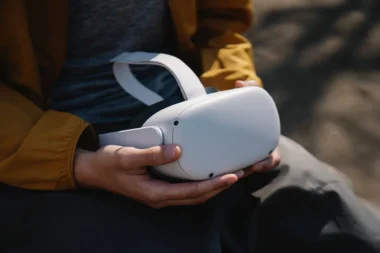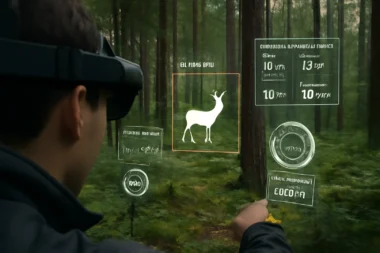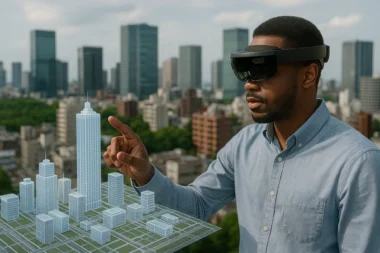Introduction to ProTubeVR
In virtual reality (VR), immersion and realistic interactions are paramount. ProTubeVR, a pioneering company in VR accessories, has taken a significant step forward by developing haptic feedback gun controllers that enhance the user’s VR experience. These innovative controllers bring a new level of realism and engagement to virtual environments, creating a more immersive and satisfying gameplay or training experience.
How the Haptic Feedback Gun Controller for Virtual Reality Works
ProTubeVR’s haptic feedback gun controller is a carefully crafted device that combines ergonomic design, precision tracking, and tactile feedback to provide an unparalleled VR experience. Let’s explore how it works:
1. Design and Construction: The haptic feedback gun controller is designed to mimic the form and feel of a firearm, enhancing the user’s sense of immersion. ProTubeVR ensures that the controller is lightweight, comfortable to hold, and provides a natural grip, enabling users to handle it efficiently during gameplay.
2. Tracking Technology: The gun controller is equipped with precise tracking technology, typically utilizing sensors like optical or magnetic trackers. These sensors detect the controller’s position and orientation in real time, allowing for accurate and responsive tracking within the virtual environment.
3. Haptic Feedback System: One of the critical features of ProTubeVR’s gun controller is its haptic feedback system. This system provides tactile sensations and vibrations that simulate the recoil or impact when firing a virtual weapon or interacting with objects in the virtual world.
4. Integrated Buttons and Controls: The gun controller incorporates various buttons, triggers, and joysticks, enabling users to perform actions and interact with the virtual environment intuitively. These controls are strategically placed for easy access, ensuring seamless gameplay or training experiences.
5. Customizable Attachments: ProTubeVR offers customizable attachments that allow users to adapt the gun controller for different virtual scenarios. These attachments can simulate various firearms or tools, enhancing realism and immersion based on the specific virtual experience.
6. Integration with VR Platforms: ProTubeVR’s haptic feedback gun controller seamlessly integrates with popular VR platforms and games. The controller communicates with the VR system, translating the user’s physical actions and input into in-game movements, firing actions, or object interactions.
Components of the device
1. Physical Housing: The physical housing of the controller is designed to resemble the form and ergonomics of a firearm. It provides a comfortable grip and intuitive handling, allowing users to easily hold and interact with the controller.
2. Tracking Sensors: The controller incorporates tracking sensors, such as optical or magnetic sensors, to capture the position and orientation of the device in real-time. These sensors precisely track the controller’s movements within the virtual environment.
3. Buttons and Triggers: The controller features buttons and triggers that serve as input mechanisms for various actions within the virtual environment. These buttons and triggers can be mapped to specific in-game functions, such as firing a weapon or reloading.
4. Haptic Feedback Mechanisms: The haptic feedback system within the controller includes components that provide tactile sensations and vibrations to the user. This can involve using motors, actuators, or other mechanisms that generate physical feedback, simulating the recoil, impact, or interaction with virtual objects.
5. Communication Interface: The controller incorporates a communication interface, such as Bluetooth or USB, to establish a connection with the VR system or gaming console. This allows the transmission of tracking data and haptic feedback commands between the controller and the VR platform.
6. Batteries and Power Management: The batteries inside haptic feedback gun controllers typically provide power. These batteries deliver the necessary power for the controller’s operation. Power management systems may be included to optimize battery life and provide an efficient power supply.
7. Attachment Points: Some haptic feedback gun controllers have attachment points or rails that allow users to customize the device with additional accessories. These attachments can include physical stocks, barrel extensions, or other accessories that enhance realism and customization options.
8. Firmware and Software: The controller contains firmware and software components that govern its operation. This includes algorithms for tracking and gesture recognition, as well as the mapping of input commands to in-game actions. Firmware and software updates may be available to improve performance and add new features.
Architecture
The architecture of a haptic feedback gun controller typically involves the following components:
1. Physical Design: The controller is designed to resemble the form and ergonomics of a firearm, ensuring a comfortable grip and intuitive handling. It may feature buttons, triggers, joysticks, and other input mechanisms strategically placed for easy access and control.
2. Tracking Technology: The controller integrates tracking technology, such as optical or magnetic sensors, to determine its position and orientation in real-time. These sensors capture the user’s physical movements and translate them into corresponding actions within the virtual environment.
3. Haptic Feedback System: The haptic feedback system is a crucial controller component. It uses motors or actuators to deliver vibrations, forces, or other tactile sensations to the user’s hand or body, simulating the recoil, impact, or interaction with virtual objects.
4. Communication Interface: The controller includes a communication interface, such as Bluetooth or USB, to establish a connection with the VR system. This enables transmitting tracking data and haptic feedback commands between the controller and the VR platform.
Framework
The framework of a haptic feedback gun controller involves the integration and coordination of various software and hardware elements:
1. Hardware Integration: The controller’s hardware components, including sensors, actuators, buttons, and triggers, are integrated and synchronized to ensure seamless functionality. This integration ensures that the controller accurately captures user input and provides appropriate haptic feedback.
2. Tracking and Positioning: The tracking technology within the controller captures the user’s movements, translating them into virtual actions. The position and orientation data are sent to the VR system, enabling real-time tracking and representation of the controller within the virtual environment.
3. Haptic Feedback Mapping: The haptic feedback system within the controller is programmed to respond to specific events or actions in the virtual environment. The mapping between virtual events and corresponding haptic feedback patterns ensures that users experience realistic sensations when firing a weapon, interacting with objects, or receiving impacts.
4. Input Mapping and Translation: The controller’s input mechanisms, such as buttons or triggers, are mapped to corresponding actions within the VR environment. For example, a trigger pull can be mapped to firing a virtual weapon. This mapping ensures that user input is accurately translated into in-game actions.
Principles
The working principle of a haptic feedback gun controller for virtual reality involves a combination of tracking technology, input recognition, and haptic feedback generation. Here is a general overview of the working principle:
1. Tracking: The controller utilizes tracking technology, such as optical or magnetic sensors, to continuously monitor the position and orientation of the device in real-time. This tracking information is then transmitted to the virtual reality system, allowing for an accurate representation of the controller’s movements within the virtual environment.
2. Input Recognition: The controller’s buttons, triggers, and other input mechanisms are mapped to specific actions or functions within the virtual environment. The controller detects the corresponding input signals when a user interacts with these input mechanisms. These signals are then translated into commands or actions that the VR system can interpret.
3. Haptic Feedback Generation: The haptic feedback system within the controller generates tactile sensations and vibrations that provide users with a sense of touch and realism. Specific events or actions within the virtual environment, such as using a weapon, striking a virtual object, or suffering an impact, cause the haptic feedback.
4. Feedback Synchronisation: The haptic feedback system is synchronized with the user’s actions and the virtual environment. For example, when a user pulls the trigger to fire a virtual weapon, the haptic feedback system generates vibrations or forces that simulate the recoil or impact of the weapon. This feedback is timed to align with the visual and audio cues in the virtual environment, enhancing the overall immersion and realism.
5. Communication with the VR System: The haptic feedback gun controller communicates through a wired or wireless connection with the VR system. This allows transmitting tracking data, input commands, and haptic feedback instructions between the controller and the virtual reality platform. The VR system interprets the input commands and updates the virtual environment accordingly.
By combining accurate tracking, input recognition, and synchronized haptic feedback generation, the haptic feedback gun controller creates a more immersive and engaging virtual reality experience. Users can feel the physical feedback associated with their actions, enhancing their sense of presence and realism within the virtual environment.
Benefits and Applications
Within the virtual reality industry, the ProTubeVR-developed haptic feedback gun controller offers a variety of advantages and applications:
1. Realistic and Immersive Experience: The haptic feedback system delivers tactile sensations that make virtual interactions more immersive and lifelike. Users can feel the recoil of a firearm, the impact of virtual objects, or the feedback when interacting with the virtual environment, enhancing the sense of presence and realism.
2. Enhanced Precision and Control: The gun controller’s ergonomic design and precise tracking technology allow for accurate and responsive gameplay or training. Users can aim with precision, perform realistic reloading actions, and engage in virtual combat or simulations with a higher level of control.
3. Training and Simulation: ProTubeVR’s gun controller is well-suited for training and simulation applications. Industries such as law enforcement, the military, or professional sports training can utilize the controller to create realistic scenarios, improving skills and decision-making in a safe and controlled virtual environment.
4. Immersive Gaming Experiences: The haptic feedback gun controller adds an extra layer of immersion and excitement for gamers. Whether exploring virtual worlds, engaging in first-person shooters, or participating in competitive gaming, the controller enhances the gameplay experience and creates a more engaging and satisfying journey.
5. Accessibility and Adaptability: The gun controller’s customizable attachments cater to individual preferences and diverse virtual scenarios. This adaptability ensures users can tailor their VR experiences based on their needs, preferences, and gameplay styles.
Conclusion
ProTubeVR’s haptic feedback gun controller represents a significant advancement in the VR accessories market. The controller enhances immersion, precision, and engagement in virtual environments by combining realistic design, precise tracking, and haptic feedback technology. Whether for gaming, training, or simulation purposes, ProTubeVR’s gun controller adds a new dimension to the VR experience, elevating it to new heights of realism and enjoyment.



